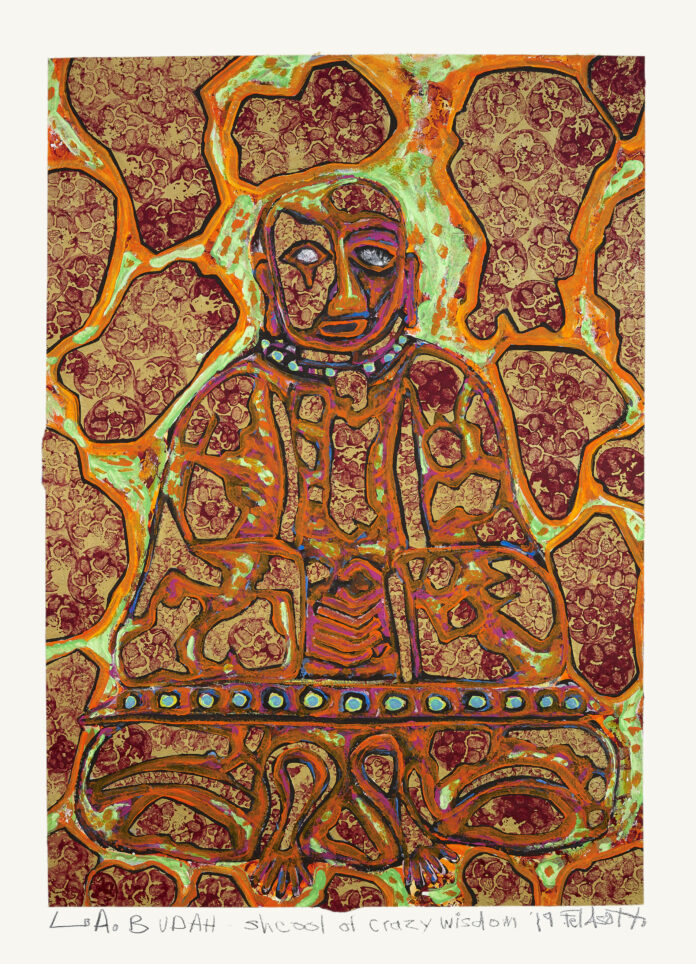The artist known by the single moniker Feldsott is something of a hidden secret. And something of a legend. And he’s having a show at Paul Mahder Gallery in Healdsburg.
Feldsott’s prolific artistic career, which began at 17 when he moved to the Bay Area and enrolled in the California College of the Arts, took off so quickly that in 1970, he found himself the youngest artist ever to exhibit at SFMOMA. By the late 1970s, Feldsott, whose style of painting mixes Picasso-esque lines with street art style, was an artist on the rise, featuring in multiple group and solo shows.
And he didn’t like it.
“When I was younger,” Feldsott reflected over the phone, “I got a lot of attention, the kind that most artists work years for. It came to me fairly easily, and all at once. And I started feeling like there were a lot of people around me who had opinions and ideas, about where my work should go, how I should be doing it. And I was too young and naive to be able to handle that kind of input. It felt completely antithetical to my role as an artist.”
Unable to handle the overbearing voices surrounding him and endeavoring to direct—and profit from—his work, Feldsott opted out.
“Without the ability to respond, I felt my only option was to retreat. To abandon the artworld, which seemed corrupt to me at that time.”
Instead, he went to Southern Mexico and South America, traveling with a friend passionate about environmentalism. Not totally clear on his path, but following his heart and enthusiasm, Feldsott met a woman who worked with Indigenous communities, helping them preserve their cultural, environmental and resource identities. She took a liking to Feldsott, and began teaching him her methods of work, and the techniques of community organization. He spent more than 25 years studying Indigenous cultures, and becoming a student of traditional medicine, learning methods of healing and teaching that he practices to this day.
During this time, Feldsott never stopped painting. In 2002, the National Museum in Quito, Ecuador offered him a show—his first in nearly two decades. He felt ready. Twenty-five years of self and world exploration will do that.
Fast forward to 2022, and Feldsott’s show at Paul Mahder Gallery, featuring a body of work called “The BuDah Paintings.” In his signature blocky, thick-brush style, Feldsott has produced myriad different paintings, all depicting the Buddha. He explained the reason behind his study to me.
“I wouldn’t have told you this when I was younger because I don’t think I could have articulated it, but my work has always been about an exploration of the primordial world. The world of primordial energies that exist underneath the day to day events. There is an energetic architecture that is like the substrate, and there are certain aspects of human consciousness and human nature that are archetypes, kind of embedded in the DNA of human consciousness. You can see them showing up across the world, these archetypal images and concepts, mythologies and cosmologies, repeated over and over again.”
For Feldsott, the Buddha is one of these figures. An archetype that embodies universal attributes like wisdom, compassion, equanimity and so on.
“These concepts existed long before there was a Buddha, long before there was the organization of Buddhism. It felt congruent to me to explore the Buddha on a primordial level. To look deeper in, to beyond the religious iconography, to look into the Buddha as an archetype of human consciousness that belongs to all human beings.”
Feldsott, back in the art world with a clear sense of mission behind his creativity, wants to show people, through in this case, the medium of painting, that we all have the ability to be inspired by ideas such as those the Buddha personifies, regardless of any religious affiliation or organized ideology. These concepts are universal.
For more information on Feldsott, visit www.feldsott.com. For gallery hours, visit www.paulmahdergallery.com.











